In this article:
Staph, or Staphylococcus, is a type of infection-causing bacteria that commonly cause skin infections. It can affect any part of the body, especially wounded areas, resulting in a severe infection. (1)
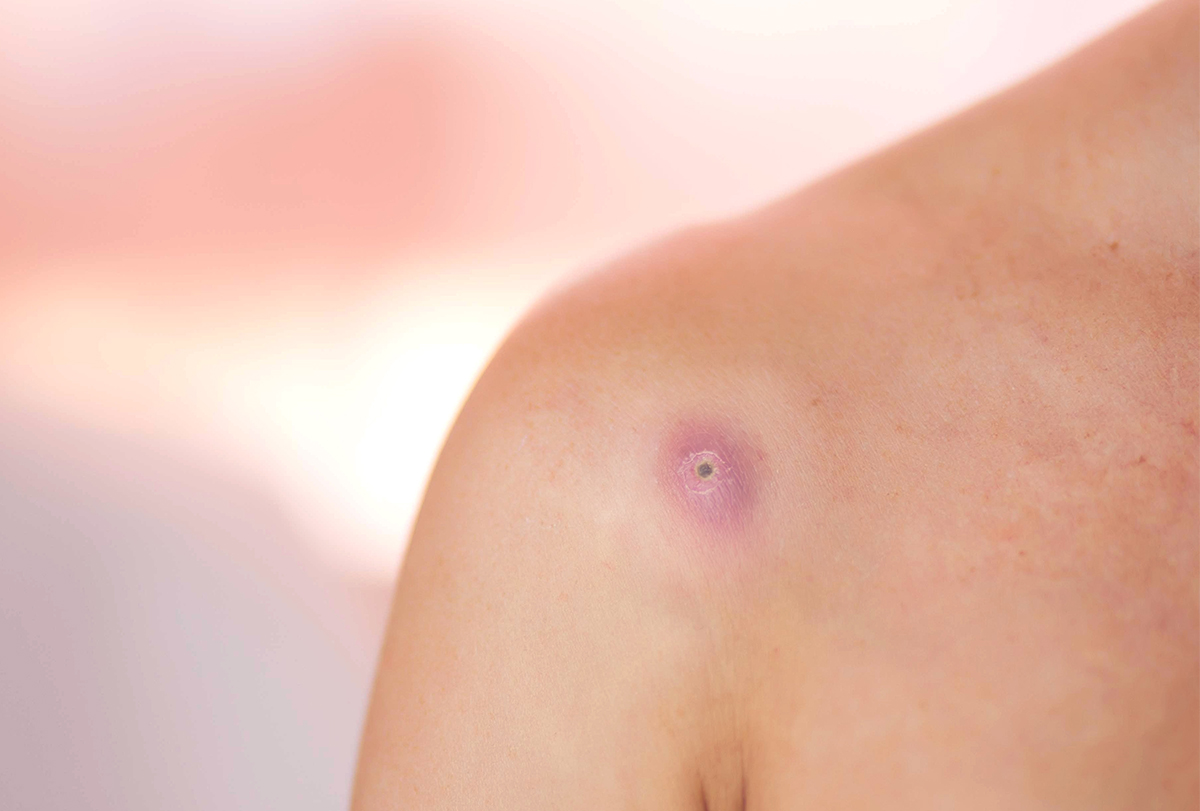
In a few cases, especially through deep wounds, catheters, or contaminated breathing tubes, the bacteria may enter the body, causing infection in the tissues, bones, and joints. The infection can also spread to vital organs such as the heart and lungs once it enters the bloodstream.
Since a staph infection can be life-threatening, it is best to have knowledge of its causes and symptoms and to consult your doctor if you suspect such an infection at the earliest.
Causes of Staph Infections
A staph infection, as mentioned above, is caused by Staphylococcus bacteria. The bacteria enter the skin through a cut or wound and multiply rapidly. This may result in redness, swelling, heat, pus accumulation, and abscess formation.
Staphylococcus is highly contagious and may enter your body through contact with contaminated surfaces. The risk of picking up the bacteria increases on sharing personal items such as towels, clothing, and linen with people who have skin infections.
The bacteria can survive in high salt levels, stomach acid, and harsh temperatures.
Signs of a Staph Infection
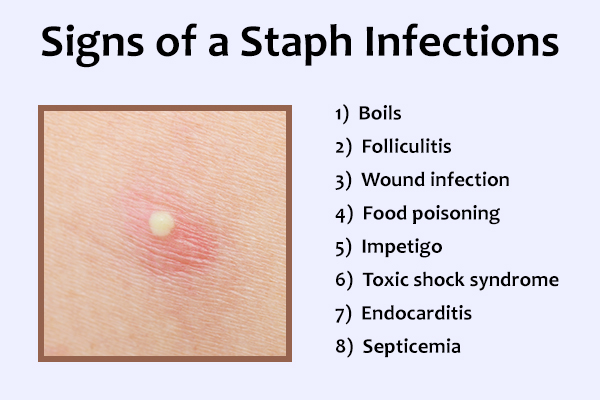
A staph infection produces different signs and symptoms depending on the area it affects. These include:
- Boils: Also known as furuncles, boils are pus-filled painful lesions. These develop when Staphylococcus aureus (S. aureus) infects hair follicles. While boils are mild, the bacteria may cause severe infection if it reaches deeper tissues. (2)
- Folliculitis: This condition refers to hair follicle infections. The lesions are small, white-headed pimples that are pus-free. Redness in the area may occur. (3)
- Wound infection: A staph infection in a wound may lead to cellulitis-like symptoms, including pain, swelling, redness, and warmth. Additionally, pus may fill in the wound and drain, forming a yellow crust. It may also cause fever.
- Food poisoning: Consuming food that’s infested with bacteria can commonly lead to food poisoning, producing symptoms such as nausea, dehydration, diarrhea, vomiting, and low blood pressure. (4) Staphylococcus is the most common bacteria that cause food poisoning.
- Impetigo: This is a type of skin infection that produces sores over the affected area. The sores may start as red, pimple-like lesions, which then get filled with pus. The pus then exudates, forming a thick crust. It is vital to resist scratching the affected skin despite the itching to avoid spreading the infection.
- Toxic shock syndrome: The bacteria may release toxins into the bloodstream and cause sepsis, presenting symptoms such as nausea, high fever, diarrhea, and vomiting. (5) This condition may occur due to skin injury, surgery, or improper tampon use.
- Endocarditis: A staph infection in the heart valves can result in endocarditis, which produces symptoms such as cough, chest pain, weight loss, and shortness of breath. (6)
- Septicemia: When Staphylococcus enters the bloodstream, it spread to multiple body parts, such as the lungs, heart, and surgical implants, causing a severe, life-threatening infection known as septicemia. (7)
Treatment for Staph Infections

The treatment for staph infections generally involves the use of antibiotics, which may be given topically or orally. When taking oral antibiotics, it is vital to complete the course to prevent resistance.
Generally, cephalosporins and penicillins are used as first-line treatment antibiotics for Staphylococcus aureus. (8) If the patient is allergic to penicillin, vancomycin may be given for the treatment of a methicillin-resistant S. aureus infection, which is otherwise avoided to prevent resistance.
Aside from the antibiotic treatment, you may need to undergo debridement surgery if the infection has infiltrated a deep wound, causing tissue damage. This procedure prevents the infection from reaching the bloodstream.
For the debridement surgery, the doctor will give you a localized anesthetic, clean the wound, and then extract all the dead and infected tissue. (9)
Diagnosing a Staph Infection
Diagnosing a staph infection involves a physical exam to look for the different signs and symptoms. The doctor may order a nasal secretion test, a skin tissue test, and blood, sputum, or urine tests to confirm the diagnosis.
Preventing Staph Infections
Since staph infections can be pretty severe, it is best to take preventive measures and avoid the infection altogether. The following tips may be useful in protecting yourself against staph infections:
1. Avoid sharing personal items
Refrain from sharing personal items such as sheets, clothing, towels, and toiletries with others, especially if one of you has a staph infection.
2. Clean your hands periodically
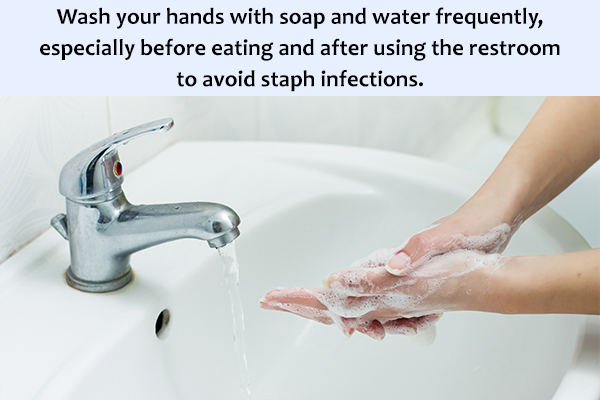
Make sure to wash your hands with soap and water frequently, especially before eating and after using the restroom.
3. Maintain good personal hygiene
Take a shower whenever you come in direct skin contact with a staph lesion or indirect contact through shared surfaces with people. Exposure may happen in public places such as gyms and health clubs.
4. Keep your surroundings clean
Since staph bacteria can be easily picked up from shared surfaces, it is vital to cleanse your surroundings habitually. For instance, wash your bed linens and towels in hot water once a week.
Regularly wipe all frequently touched surfaces such as countertops, light switches, and doorknobs using a disinfectant.
5. Clean and cover open cuts
Clean all cuts, wounds, scrapes, and incisions properly and keep them covered with a bandage to prevent entry of bacteria. Continue doing so until they heal.
When showering, use a natural antibacterial wash and ensure to cover any gaps in the skin, especially if you’re in a high-risk environment such as a hospital or nursing home.
6. Use disposable gloves
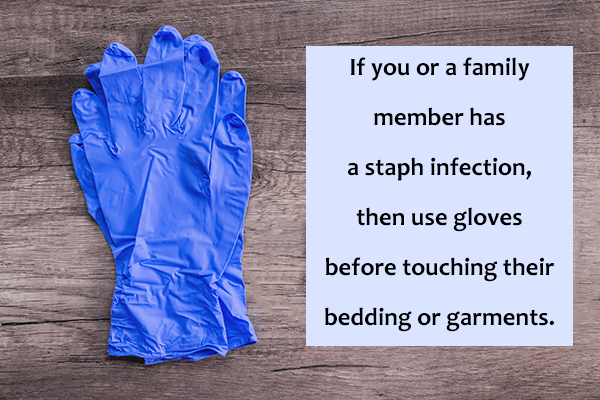
If you or a family member has a staph infection, use gloves before touching their bedding or garments. Properly dispose of the gloves and wash your hands afterward.
7. Change tampons frequently
Toxic shock syndrome occurs due to prolonged use of a single tampon for more than 8 hours. Therefore, remember to change your tampon every 4–6 hours.
8. Try diluted bleach baths
Taking diluted bleach baths two times a week may help in preventing staph infections.
Risk Factors
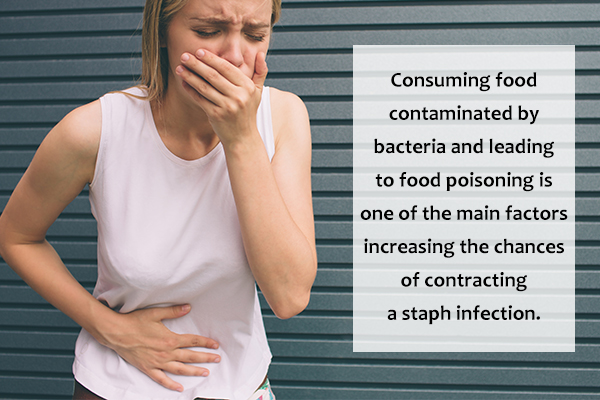
A number of factors can increase the chances of contracting staph infections, including:
- Consuming bacteria-contaminated foods, leading to food poisoning
- Sharing personal items such as cosmetics, razors, and towels
- Recent hospital or care facility stay
- Medical conditions such as lung disease, cancer, vascular disease, or diabetes
- Wound or recent surgery
- Weak immune system due to HIV/AIDS or the use of immunosuppressant drugs
When to See a Doctor
Consult your doctor if you notice any signs of a staph infection. Also, schedule an appointment with your doctor if:
- Skin infections are prevalent in your family or more than two people are having a skin infection at the same time.
- If the symptoms appear suddenly or do not improve in a week.
- The affected skin develops inflammation, discoloration, or redness.
- You have a weak or compromised immune system.
How Long Does It Take for a Staph Infection to Heal?

The time required for staph infections to clear up depends on the type of infection and the treatment undertaken. For example, a boil may clear up in 10–20 days.
Final Word
Staphylococcus is an infectious microorganism that generally causes minor skin infections. However, they may also cause severe problems such as endocarditis and sepsis if the bacteria reach the bloodstream or vital organs.
Staph infections, therefore, should be treated and controlled at the earliest. You must consult your doctor for suitable antibiotics and complete the recommended treatment. It is also important to observe preventive measures to avoid spreading or contracting staph infections.
- Was this article helpful?
- YES, THANKS!NOT REALLY


